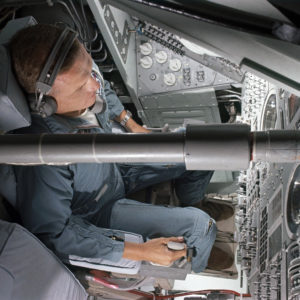There had been wars before 1968. There had been riots before 1968. There had been assassinations before 1968. But something noble happened in 1968. Three daring men circled the moon. Apollo 8 actually redeemed mankind and 1968.
The drama, discipline and derring-do of the extraordinary mission is marvelously documented in two recent books: “Apollo 8” by Jeff Kluger, and “Rocket Men” by Robert Kurson.
Project Apollo was conceived in the waning days of President Dwight D. Eisenhower’s administration in 1960, when Americans feared they were losing the “space race” to the Russians during the Cold War. But it wasn’t until President John F. Kennedy articulated a grander vision at Rice University in September 1962 that galvanized space exploration and a manned lunar landing into a national calling. No expression of early 1960s idealism was better.
Kennedy said, “The growth of our science and education will be enriched by new knowledge of our universe and environment, by new techniques of learning and mapping and observation, by new tools and computers for industry, medicine, the home as well as the school.”
His celestial aspirations included “new hopes for knowledge and peace.” He also sought divine guidance: “As we set sail, we ask God’s blessing on the most hazardous and dangerous and greatest adventure on which man has ever embarked.”
Halfway through the decade, as America was bleeding, NASA (and a team of 400,000 people) was preparing. For the heavens.
But by mid-1968, with only 18 months to achieve Kennedy’s goal of landing a man on the moon and returning him safely to the Earth by decade’s end, the objective was in jeopardy. No Apollo astronauts had flown in space since the Apollo 1 launch pad fire killed three astronauts in January 1967. And the lunar lander wouldn’t be ready for the flight until early 1969.
Fifty years ago this summer, NASA made an unbelievably bold decision: Apollo 8 would circumnavigate the moon in December. Everyone understood the risks: unlike future missions, there was no lifeboat should catastrophic failure occur aboard the spacecraft.
The journey would test the nation’s best engineers in areas like navigation, communication, computation and instrumentation. Not to mention rocketry. And nerves.
(Today’s iPhone has more processing power than the guidance computer on Apollo’s command module.)
Apollo 8 circled the moon on Christmas Eve.
During a live global broadcast (the largest audience in history), the astronauts recited words worthy of the moment. As the grainy, gray surface of the moon passed by, William Anders, Frank Borman and Jim Lovell each read from the Book of Genesis. “We close,” said Borman, “with good night, good luck, a Merry Christmas, and God bless all of you — all of you on the good Earth.”
Yet it was a simple but starkly beautiful photograph taken by Anders and published around the world on December 30 that captured the legacy of what The New York Times described then as “the most fantastic voyage of all time.” Simply called “Earthrise,” it became an iconic image of 1968. And of all history.
Apollo 8 would mark several historical firsts: The first time humans left the Earth’s gravitational field; the first time men flew on top of the massive Saturn V rocket (nearly 60 feet taller than the Statue of Liberty; the most powerful machine ever built, it produced 160 million horsepower); and the first time ever the dark side of the moon was seen by the naked eye. (The flight would also mark the fastest people had moved; the astronauts re-entered the Earth’s atmosphere at 35,000 feet per second.) The crew became, rightly, international heroes.
Kennedy’s audacity was rewarded in July 1969 with the triumph of the Apollo 11 landing. That could not have happened without the critical success of Apollo 8.
The national investment in Project Apollo cost $25.4 billion by its conclusion in 1973 or $206 billion in 2016 dollars. (America will spend $310 billion in debt service just in 2018.) A remnant from bygone era, Apollo may have been the last large federal public works program that invested for the future and not borrowed from it.

